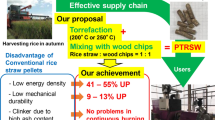Abstract
A technique for controlled burning of rice straw is presented. It relies on well-designed rice straw pellets to be burned in fluidized bed. The developed pellets have high burning rate, no fly ashes emissions and minimum bed fouling. The pellets are manufactured from ground rice straw in a disc pelletizer with the aid of bonding and suitable additive materials. The pellets are tested under controlled conditions in a test rig, which represents a single pellet fluidized bed. It is equipped with a nitrogen gun to eject the pellet and freeze the reaction at any predetermined time during combustion. The ejected pellets are weighed as well as elementary analyzed for both carbon and hydrogen, to calculate the burning rate as well as the combustion efficiency, respectively. The effect of several parameters has been evaluated including straw particle size, pellet size, type and concentration of bonding material as well as anti-sintering additives. Also, the pellets’ mechanical characteristics have been evaluated. It has been found that char combustion phase represents the controlling phase of the pellet combustion. The burning rate is higher as the void fraction of the pellet is higher. Starch showed better combustion and mechanical characteristics out of the five tested bonding materials. Adding kaolin to the pellets results in improving the sintering characteristics of the pellets. The experimental results were compared with two combustion models: the oxygen diffusion controlled and the kinetic-diffusion models. It has been found that oxygen diffusion controlled model more accurately simulates the combustion of the pellet during its char combustion phase. The model has been used to evaluate the effect of some operational parameters on the pellet combustion characteristics such as bed temperature, gas flow and oxygen concentration.
















Similar content being viewed by others
Abbreviations
- A :
-
surface area of char particle (m2)
- C :
-
concentration (kg/m3)
- C fix :
-
fraction of fixed carbon
- D :
-
diffusion coefficient (m2/s)
- d :
-
diameter (m)
- K app :
-
apparent combustion rate (m/s)
- K s :
-
chemical reaction rate constant (m/s)
- M :
-
molecular mass
- m :
-
mass
- m c :
-
mass flux from boundary layer diffusion (kg/m2 s)
- S :
-
stoichiometric coefficient
- Sh :
-
Sherwood number
- T :
-
temperature
- t :
-
time (s)
- Y :
-
mole fraction of oxygen
- ζ :
-
void fraction
- ρ :
-
density
- γ :
-
factor equal to (Ψ−1)/(Ψ+1)
- Ψ :
-
carbon fraction converted to CO2 for each mole of carbon consumed
- Γ :
-
oxygen stoichiometric coefficient for each mole of carbon
- β :
-
mass transfer coefficient
- α :
-
convection heat transfer coefficient
- ΔH :
-
heat of reaction (J/kg O2)
- 0:
-
initial
- ABF:
-
at boundary layer film
- app:
-
apparent
- b:
-
bed
- c:
-
carbon
- cc:
-
char combustion
- g:
-
gas
- o2 :
-
oxygen
- p:
-
pellet
- s:
-
solid, surface
References
Agarwal AK, Agarwal GD (1999) Recent technologies for the conversion of biomass into energy, fuels, and useful chemicals. TERI Inf Monit Environ Sci 4(1):1–12
Bain RL, Ralph PO, Kevin RC (1998) Biomass-fired power generation. Fuel Process Technol 54:1–16
Dasilva BJ (1978) Biogas generation: developments, problems, and tasks—an overview. In: Conference on bioconversion of organic residues for rural communities. Institute of Nutrition of Central America and Panama, Guatemala, 13–15 November 1978
Denisse A (2000) Gasification of lignin from rice straw. http://www.nrel.gov/docs/gen/fy01/nn0029.pdf (August 18)
Hong J (2000) Modeling char oxidation as a function of pressure using an intrinsic Langmuir rate equation. PhD, Brigham Young University
John WT, Anthony DW (2000) Renewable energy resources. Spon Press
Leckner B, Hansson K-M, Tullin C, Borodulya AV, Dikalenko VI, Palchonok GI (1999) Kinetics of fluidized bed combustion of wood pellets. In: Proceedings of the 15th international conference on fluidized bed combustion, Savannah, GA, 16–19 May 1999
Mahmoud MM (2004) Experimental study on a novel technique for rice straw burning minimizing emissions. MSc Thesis, Faculty of Engineering, Zagazig University
Saito M, Amagai K, Ogiwara G, Arai M (2001) Combustion characteristics of waste material containing high moisture. Fuel 80:1201–1209
Spliethoff H (2001) Status of biomass gasification for power production. IFRF Combust J, article number 200109, November
Zanzi R, Sjöstörm K, Bjömbom E (1995) Rapid pyrolysis of bagasse at high temperatures. In: Proceeding of the third Asia-Pacific international symposium on combustion and energy utilization, Hong-Kong, 11–15 December 1995, vol 1, pp 211–215
Zygarlicke JC, Kurt EE, McCollar PD, Musich AM, Toman LD (2000a) Impacts of co-firing biomass with fossil fuels. In: Proceedings of the 25th international technical conference on coal utilization and fuel systems, Clearwater, FL, 6–9 March 2000
Zygarlicke JC, Pavlish HJ, Gunderson RJ, Mccollar PD (2000b) Ash behaviour and combustion performance during the co-firing of rice straw lignin and coal. In: The ninth biennial bio-energy conference, Bio-energy 2000, Buffalo, NY, October 2000
Author information
Authors and Affiliations
Corresponding author
Rights and permissions
About this article
Cite this article
Ewida, K.T., El-Salmawy, H., Atta, N.N. et al. A sustainable approach to the recycling of rice straw through pelletization and controlled burning. Clean Techn Environ Policy 8, 188–197 (2006). https://doi.org/10.1007/s10098-006-0043-x
Received:
Accepted:
Published:
Issue Date:
DOI: https://doi.org/10.1007/s10098-006-0043-x




